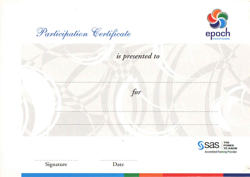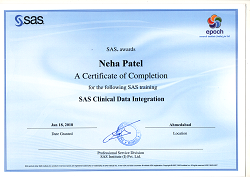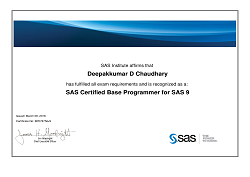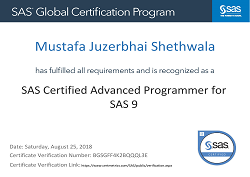- Home
- Epoch, SAS and Quartesian LLC - Clinical Trial Programmer Joint Certification Program
Epoch, SAS and Quartesian LLC - Clinical Trial Programmer Joint Certification Program
A joint certification program of Epoch, SAS and Quartesian LLC aims to train students and provide extensive knowledge on SAS Programming skills.
Power up your staff’s skills and boost your business
Course Description
- Joint Training & Certification Program
- Duration – 9 Months
- Clinical SAS Programming -Clinical Data Analysis & Reporting
- Employment Oriented Program
About Program
A joint training program of Epoch (SAS Training-) and Quartesian LLC (Clinical Data Analysis and Reporting) aims to train students and provide extensive knowledge on SAS programming skills followed by basic understanding about Clinical Trials Domain such as Introduction to Clinical Trials, Overview of CRO industry, Good documentation practice and Guidelines, along with essential communication skills needed by Clinical SAS Programmer. Further to this, participants will be able to get hands on training/experience with mock assignments on Study documents, Standards- SDTM & ADaM and Creating TLF's, mentored by Quartesian LLC experts.
Assessment and evaluation mechanism developed by Quartesian LLC will help participants to build and grow their profile similar to the level of experience professional. Epoch and Quartesian LLC training, Combination of relevant Theoretical and Practical exposure, together will enable profiles to work in the industry with ease and satisfy the severe shortage of skilled manpower of growing clinical research industry.
Format of Training
Taught by certified instructors at High-Tech facilities across the country:
- A SAS expert at your side.
- Focused learning away from the office
- Networking opportunities
- State-of-the-art facilities
- Electronic course notes downloadable to your device and permission to print
- Business Knowledge Series: in-depth courses on the latest business topics
- We offer Connected Classes! Watch for courses in Cary, New York, Arlington, Dallas and San Francisco that connect remote students via our Live Web classroom.
Prerequisite
Who should attend
This program enable candidate to become clinical SAS® programmer by undergoing comprehensive training which includes case studies, and industry level project work. All candidates are expected to have good aptitude and be familiar with overall computer programming skills.
Candidates are Preferred From
Graduates or Post Graduates from
- Life Sciences - B. Sc./ M. Sc.,
- Pharmacy - B. Pharmacy / M. Pharmacy
- Statistics - B. Sc. / M. Sc.
- Medical - MBBS, BDS, BHMS, BAMS
- Engineering - BE / B. Tech (Biotechnology, Bioinformatics, Computer Science) or M. Tech
Or Relevant experience of pharmaceutical/life science industry
Training Features
Through the presentations slides provided by SAS® on LCD Projector. Each student gets the personal computer desktop for the classes as well as practice at Epoch. Clinical domain training and Internship projects will be delivered at Quartesian LLC campus.
- Classroom Training on SAS Programming & Practice Sessions
- Accredited Trainers at Epoch & Experienced Mentors at Quartesian LLC LLC for Support
- Internship
- Assessment & Evaluation
- SAS Certification
Course Curriculum
Course Logistics and Overview
- course logistics
- SAS/GRAPH and ODS graphics
- introduction to SAS/GRAPH
- graph gallery
Graphical Reporting with SAS/GRAPH
- how SAS/GRAPH creates output
- SAS/GRAPH program structure
- controlling the appearance of your graphs
Producing Scatter and Line Plots
- creating scatter plots
- creating line plots
- creating plots containing multiple lines
- creating other types of plots with individual data points
Producing Bar Charts
- creating vertical and horizontal bar charts
- creating grouped and subgrouped bar charts li>creating bar-line charts
Producing Other Types of Charts
- creating pie charts
- creating star charts
- creating radar charts
- creating tile charts
- creating key performance indicator charts
Customizing the Appearance of SAS/GRAPH Output
- colors and fonts
- customizing common graphics elements
- titles and footnotes
- customizing plot symbols
- specifying chart pattern colors
Customizing Axes and Legends
- customizing plot and chart axes using procedure options
- customizing axes with AXIS statements (basic options)
- customizing axes with AXIS statements (additional options)
- customizing legends
Annotating Graphs
- introduction to annotate
- defining annotate variables
- using annotate macros
- creating data-dependent annotations
Generating Graphs for Use in Other Applications
- creating image files
- creating client-rendered graphs
- creating clickable graphs for the web using ODS
Managing and Replaying SAS/GRAPH Output
- storing and naming graphics output
- using the GREPLAY procedure
Learning More
- additional SAS resources
- beyond this course
SAS® Certified Base Programmer for SAS®9 - Certification
The perfect starting point for those interested in a career as a SAS® professional
Successful candidates should have experience in programming and data management using SAS®9 and should be able to:
- Import and export raw data files.
- Manipulate and transform data.
- Combine SAS data sets.
- Create basic detail and summary reports using SAS procedures.
- Identify and correct data, syntax and programming logic errors.
Candidates who earn this credential will have earned a passing score on the SAS® Base Programming for SAS®9 exam.
Exam Content & Pricing
This exam is administered by SAS and Pearson VUE.
- 60-65 multiple-choice and short-answer questions.
(Must achieve score of 70 percent correct to pass) - 110 minutes to complete exam.
- Use exam ID A00-211; required when registering with Pearson VUE.
- This exam is based on SAS 9.4.
Exam Content & Pricing
Candidates who earn this credential will have earned a passing score on the SAS® Base Programming for SAS®9 exam.
This exam is administered by SAS and Pearson VUE.
- 60-65 multiple-choice and short-answer questions.
(Must achieve score of 70 percent correct to pass) - 110 minutes to complete exam.
- Use exam ID A00-211; required when registering with Pearson VUE.
- This exam is based on SAS 9.4.
Exam - Location
Epoch has three faclities approved for conducting exam.
SAS Macro Language 1: Essentials
This course focuses on the components of the SAS macro facility and how to design, write, and debug macro systems. Emphasis is placed on understanding how programs with macro code are processed.
Learn how to
- perform text substitution in SAS code
- automate and customize the production of SAS code
- conditionally or iteratively construct SAS code
- use macro variables and macro functions.
SAS SQL 1: Essentials
This course teaches you how to process SAS data using Structured Query Language (SQL).
Learn how to
- query and subset data
- summarize and present data
- combine tables, including complex joins and merges
- create and modify table views and indexes
- replace multiple DATA and PROC steps with one SQL query.
SAS Programming 3: Advanced Techniques and Efficiencies
This course is for SAS programmers who prepare data for analysis. The comparisons of manipulation techniques and resource cost benefits are designed to help programmers choose the most appropriate technique for their data situation.
Learn how to compare various SAS programming techniques that enable you to
- benchmark computer resource usage
- control memory, I/O, and CPU resources
- create and use indexes
- combine data horizontally
- use hash and hiter DATA step component objects and arrays as lookup tables
- compress SAS data sets
- sample your SAS data sets
- create and use SAS data views
- safely reduce the length of numeric variables
- create user-defined functions and informats.
Introduction to Reporting and ODS
- course logistics
- introduction to reporting
- introduction to ODS
- ODS with the SAS interfaces
- creating reports with the PRINT procedure
Getting Started with the TABULATE Procedure
- introduction to the TABULATE procedure
- creating the structure of the table
- adding overall summarizations
- adding additional statistics
Doing More with the TABULATE Procedure
- enhancing with labels and formats
- enhancing with options
- adding trafficlighting
- adding additional style attributes
Getting Started with the REPORT Procedure
- introduction to the REPORT procedure
- creating a detail report
- creating a summary report with the GROUP usage
- creating a summary report with the ACROSS usage
- computing an additional column
Doing More with the REPORT Procedure
- adding summary lines
- customizing break lines
- adding trafficlighting and style attributes
- using the CALL DEFINE statement
Using ODS Destinations
- introduction to ODS destinations
- PRINTER and RTF destinations
- CSV and HTML destinations
- Excel and other destinations
- SAS destinations
Doing More with ODS
- using ODS options and statements
- using ODS ESCAPECHAR
- controlling bookmarks and the table of contents
- using ODS layout
Introduction to SG Procedures
- introduction to ODS graphics
- using the SG procedures
Learning More
- introduction
Project
- loading the DM (Demographics) domain
- loading the XP (Pain Diary) domain
- loading the SUPPDM (Supplemental Demographics) domain
- loading the QS (Questionnaire) domain
- creating a standard CRT-DDS Define.xml document
- creating customized CRT-DDS Define.xml documents

 Course Description
Course Description About Program
About Program Format of Training
Format of Training Prerequisite
Prerequisite Training Features
Training Features Course Curriculum
Course Curriculum Project
Project Certificate
Certificate Course Fees
Course Fees

 Watch
Watch Contact
Contact




 Find My Path
Find My Path